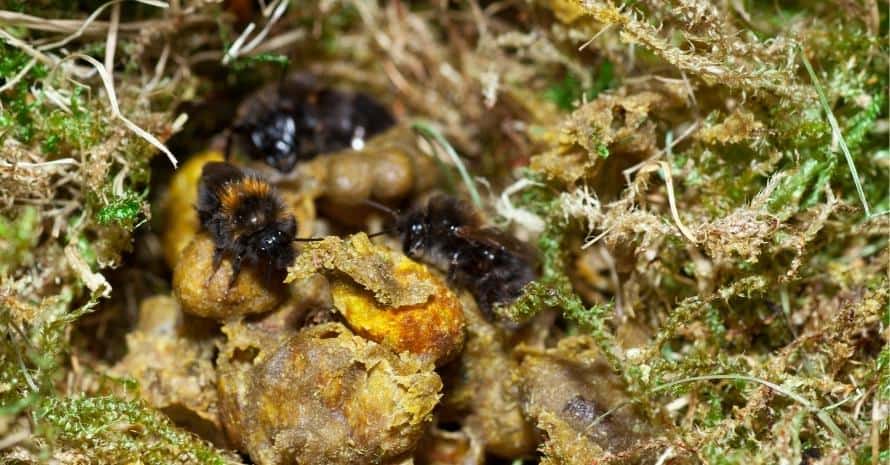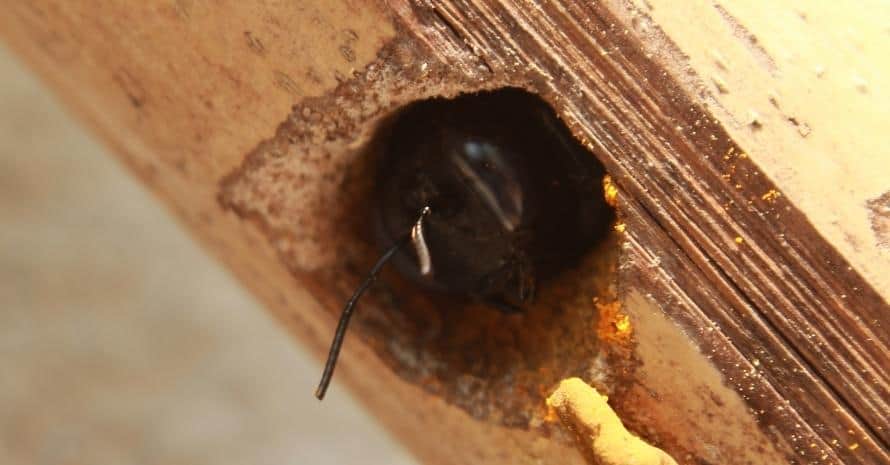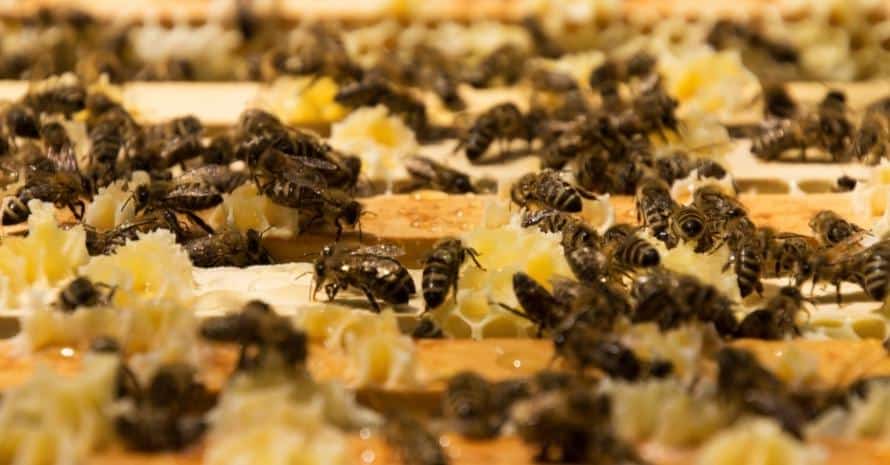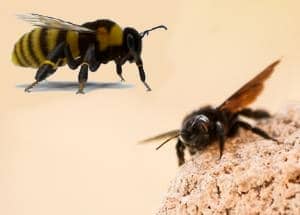The differences between honeybees and bumblebees are obvious, but it’s not the case for carpenter bees. It’s very easy to confuse these two bee types because of their visual similarities.
If you saw a carpenter bee in your home yard, that is an alarming sign, but if you found a bumble bee, there is nothing to worry about. So, we’ve made a bumble bee Vs carpenter bee comparison to help you identify the insects correctly.
Taking a Closer Look at Carpenter Bees and Bumble Bees
Bumblebees vs Carpenter Bees Appearance
There are a bunch of visual characteristics that may help you to distinguish these two insects:
- Carpenter bees’ body color is usually dark gray or even black. In contrast, bumble bees’ chests are always colored yellow.
- Carpenter bee size is huge. Bumble bees are smaller and shorter: 0,4”- 0,8” vs 0,9”- 0,11”.
- Bumble bees are much fluffier: bushy villi on sphere-shaped bodies gave them a “bumble” name.
- Carpenter bees usually have purple or dark blue wings. Bumble bees – translucent orange wings that are smaller in size.
Hive building and appearance
Principles of choosing and building nests are pretty different for these bee types.
Bumblebee nests
Bumble bees usually search for holes and tunnels in the ground or, rarely, in trees and in houses. They do not dig them on their own but settle down in abandoned holes and burrows. Typical homes for the bumble bees usually are the burrows left by rabbits, moles, shrews or natural deepenings like small ground caves.

Despite the fact that they build a nest in the ground, the structure of the nest itself is pretty similar to the honeybees’ ones. Bumble bees fill the nest with honeycombs and cover the walls with nectar and pollen.
Carpenter bee nests
The main difference between carpenter bees and bumblebees is that wood bees dig their nests in dry wood. This is the only bee type that has chews strong enough to gnaw tunnels in such a hard material.
Even more, the tunnels made by these bees have clear circle-shaped diameters (usually 0,6”).

Wide systems with dozens of long tunnels and halls don’t have one ounce of honey. The reason is that these bees do not belong to the honey-producing type.
Instead of making honey, they collect nectar and pollen to make a nourishing mixture that will be stacked into the cells with larvae. The cells themselves are built right in the tunnels one after another and are separated by strong walls made of wood chips and bees’ saliva.
Tunnel systems of these insects weaken the wood and may cause problems with the sustainability of the house.
Differences in ways of relocation
Bumblebee versus carpenter bee battle continues even in how they relocate. It’s impossible to remove a carpenter bee nest without touching the material where the nest is dug out. So, there is one way left – making their life in the nest unbearable.
Turn on loud music, plant herbs like lemon balm or Melissa, paint the wood and they will leave by themselves. After the swarm leaves their home, take measures to prevent bees in future: seal entrances to the nest and all gaps, cracks, and treat the wood.
Bumble bees’ nests are pretty similar to the honey bees’ ones, so the technique is pretty the same. You smoke out the nest in the early morning or in the late evening, place the nest in a special box and move it at least 4 miles away from the original place of living.
Surely, you shouldn’t forget about safety measures during these operations. Even despite the fact that bumble bees and carpenter bees are pretty friendly, you may trigger an attack while operating near the nest.
Colonies
A generation change occurs in the spring for both bee types, but carpenter bees and bumblebees have different approaches in building up new colonies and swarms.

The bumble bees’ youth tend to leave their nest to find a new place after the old one is overfilled. In contrast, carpenter bees prefer to prolong tunnels systems for years making new entrances, halls etc.
Even more, several female carpenter bees may share one entrance and one nest which is exotic for the bee family – usually female species fight for supremacy over the whole swarm.
Behaviour
Carpenter bees and bumble bees belong to one family, so the behavior is pretty similar for both types. However, there are a couple of differences.
Habits

Carpenter bees and bumblebees both play the role of pollinators in the ecosystem. So, both bee types spend their lives searching for nectar and flying from one flower to another.
They are attracted by sweet smells, water and bright colors. The main difference here is in the nest-building: carpenter bees dig nests in wood and bumble bees build their homes in the ground or in peoples’ houses.
Aggression
Carpenter bees and bumble bees are not aggressive and completely friendly to people. However, they may attack you if you try to offend them or the nest by waving your hands away, getting too close etc.
Only female species of these two bee types have a stinger, so it’s unlikely that you’ll be bitten. However, you shouldn’t neglect the safety rules. If you were stung, immediately go to a hospital – carpenter bee or bumblebee stinger is dangerous. Even more, it may be lethal in case the bite site is somewhere around the neck.
FAQ

Some frequently asked questions about bumble bees and carpenter bees.
Do carpenter bees sting or bite you?
Only female carpenter bees can sting you, male species just don’t have a sting. Even despite the fact that this bee type is friendly to people, be careful – a sting in the neck of the female carpenter bee may be lethal for you.
Do bumble bees make holes in wood?
No, they don’t. Bumble bees live and build their nests in abandoned burrows or in trees’ hollows. Only carpenter bees gnaw out tunnels in wood to make a hive.
Why do carpenter bees fly at you?
Carpenter bees are not aggressive and the majority of the population is unable to sting or bite. Most likely they are attracted by your smell or your colorful clothes. Also, it’s possible that they’re trying to defend the nest nearby.
Is it that hard to distinguish bumblebee and carpenter bee?
No, it’s easy. Follow the steps in the article to identify the type of the bee. Remember that bees are the peoples’ friends and sometimes it’s much better to leave them or let them fly away peacefully than trying to get rid of them in radical ways.
Have you ever had a bumble bees’ nest in your home yard? Maybe carpenter bees in the house? How did you cope with it? Share your experience in the comments below.
Also read:
- Best Bee Killer Spray
- How to Get Rid of Ground Bees
- How to Get Rid of Sweat Bees
- How Do Carpenter Bee Traps Work
- How to Make a Carpenter Bee Trap
- Citrus Spray for Carpenter Bees
- Carpenter Bee Trap Bait
References
- Why You Shouldn’t Kill the Bees in Your Garden (Peter)
https://www.mrpest.ca/why-you-shouldnt-kill-bees-in-your-garden/ - Moving Bees (The Bedfordshire Beekeepers Association)
https://www.bedsbka.org.uk/membership/good-practice/moving-bees/ - Large Carpenter Bees (E.E. Grissell, Florida Department of Agriculture and Consumer Services, Division of Plant Industry; Malcolm T. Sanford (retired) and Thomas R. Fasulo (retired), University of Florida)
https://entnemdept.ufl.edu/creatures/misc/bees/xylocopa.htm


